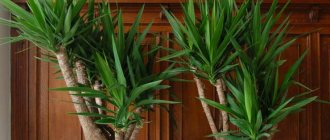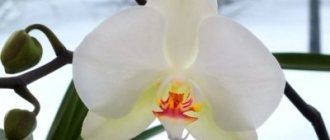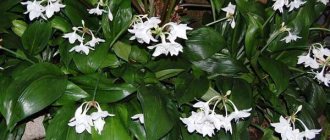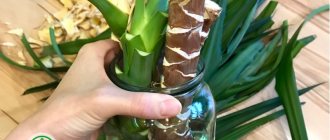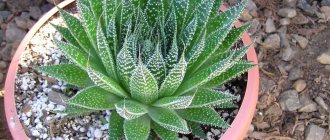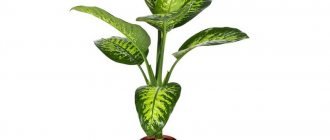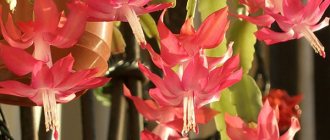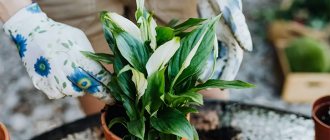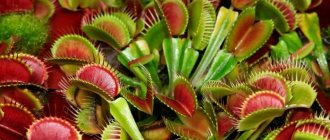The exotic plant yucca has firmly taken its place on the windowsills of experienced gardeners. Having an original appearance, it decorates the room and fits perfectly into the interior of the room.
In order for it to grow well and not get sick, it is necessary to take proper care of the yucca plant at home. What and how to do to preserve beauty, find out all the details.
There is a similar article on this topic. You will find it very interesting - Garden Yucca: planting and care. When to replant?
Landing
The well-being of the plant will ensure that certain rules when planting the plant after purchase.
In the garden
For the garden, plants with a closed root system are usually purchased - in a container . This yucca can be planted at almost any time of the year, the root system will not be damaged, but it is better at the beginning of the warm season, then adaptation will be painless.
Homemade yucca palm: care at home
After purchasing a yucca, it, like all new plants, is quarantined for at least 2 weeks - placed separately in a place with diffused light. During this time, the plant adapts to the microclimate of the room, and all possible ailments will be identified and cured.
After the adaptation period, the yucca can be transferred to a suitable container and placed in a permanent place.
Kinds
Yucca aloifolia
A perennial with an erect trunk and a rosette of sword-shaped leaves at its top. The leaves are belt-shaped or lanceolate, olive-green in color, up to 55 cm long, arranged in a spiral.
Yucca elephantipes
The most common species in floriculture. In its natural habitat it is a very tall tree, the stem is thick and branched in the upper part, the leaves are 30-75 cm long and 5-8 cm wide, pointed at the top and tapering towards the base, sword-shaped, green. In a room, yucca of this species grows up to one and a half meters in height.
Yucca filamentosa
An almost stemless plant that grows horizontally thanks to root shoots. The root system is very deep, so this species is the most winter-hardy of all the others and can withstand frosts down to -20 ºC! The leaves are up to 70 cm long, up to 4 cm wide, bluish-green in color, with a pointed tip and pubescent edges with thin white twisted threads. It has a variegated shape with yellow-green or white-variegated leaves.
Yucca glauca
Also a stemless plant with narrow-linear leaves up to 70 cm long, bluish-green in color with a light border and thin, sparse, curly threads along the edge of the leaf.
The most commonly cultivated plants are Yucca ivory and Yucca aloe vera.
Lighting
Yucca loves good lighting . Its leaves are covered with a thin layer of waxy coating; they are dense, tough and perfectly adapted to all kinds of living conditions. Therefore, she is not afraid of even the brightest sunlight. In summer it can withstand even the brightest sun provided there is good aeration, i.e. sufficient supply of fresh air.
In winter, lighting depends on temperature .
Temperature
In summer, the air temperature can be almost any : yucca tolerates temperatures above 30, especially in the fresh air or in a well-ventilated area.
Rest period
In winter, yucca needs coolness for at least 2 months. This is not a slight drop in temperature, but rather cool conditions, +5 - +8°C.
With such maintenance, lighting does not play - the plant is at rest and does not grow .
This period is very important for development - flower buds are laid. With such content, additional lighting may not be necessary.
If it is not possible to arrange a cool winter, then it is necessary to provide the plant with as much natural and artificial light as possible, otherwise it will stretch, bend the trunk and fade.
When grown in the garden, yucca sometimes requires shelter for the winter. The yucca is wrapped in several layers of thick paper or cardboard, the packaging is secured, and the ground around is mulched with sawdust, straw, or insulated with spruce branches.
In areas where the winter temperature drops below -10°C , it is advisable to grow yucca year-round in a pot, taking it outside during the warm season.
Air humidity
Yucca tolerates dry indoor air, but atmospheric moisture has a positive effect on its appearance and well-being, especially at high temperatures.
Watering
In the warm season, with active growth, you need to water abundantly , but not often. Moisten the soil for yucca in a pot only after the earthen clod has completely dried out.
IMPORTANT! When water stagnates, fungi and algae very quickly settle in the soil, to which yucca is sensitive.
during the dormant period is even more dangerous . At this time, there is a high risk of root rotting. In the cool winter, yucca is watered very rarely and very little at a time so that the roots do not dry out. This is exactly the case when it is better to underfill than overfill.
Mysterious yucca
Who is she, this exotic beauty? In appearance, the plant is very reminiscent of a palm tree, but in reality it has nothing to do with it. For such a misunderstanding, the yucca was nicknamed the false palm.
This is interesting. Quite a lot of people left the Yucca genus and families. At first it was classified as a Liliaceae, then included in the Agave family. According to the latest data, the Yucca genus was transferred to Asparagus.
In her homeland there are many legends about the mysterious beauty. Ancient beliefs claim that the flower brings happiness, health and joy to the house, and helps in business. A beautiful and well-groomed flower encourages intimate conversations and helps to avoid discord and quarrels.
There are more than 20 varieties of yucca. Some of them are grown in the south and center of Europe in the open air. In Russia, the false palm can only winter in the southern regions. In the central and northern regions of the country, exotic is cultivated only as a houseplant.
In the summer, the tub with yucca can be taken outside and placed in a place protected from the winds.
Almost all plants of the Yucca genus have an attractive appearance. The woody stem, sometimes branched many times, ends in a cap of large, lanceolate leaves. Their color varies from light green to gray, sometimes yellow stripes or the same edging appear. There are varieties with purple foliage.
Indoor yucca blooms very rarely. It is possible to achieve the appearance of bell-shaped buds only after 10–15 years, providing the plant with a decrease in temperature in winter to -5...-7 ° C. Garden crops bloom annually, delighting the owners with a huge snow-white panicle.
Transfer
Young specimens of the plant are replanted annually in the spring . There are three ways to change the amount and composition of soil in a container - transshipment, replanting, and replacing the top layer.
Transshipment
The essence of the method is to simply remove the plant from the pot and transfer it to another, slightly larger one, along with a lump of earth.
Fill the gaps between the roots and the container with fresh soil. First pour drainage ; after installation, you can change the top layer by carefully removing it and adding fresh mixture .
Complete change of soil
In this procedure, it is important to remove as much soil as possible, untangle and trim the roots, remove rotten ones, while trying not to injure whole and short ones. It is convenient to free the roots with a stick .
a pot prepared in advance , the substrate is poured into a mound, and the plant is placed on it. When filling the roots, shake the pot from time to time or tap it on the table - the earth penetrates inside the root lobe. The surface level is not changed; the diameter of the pot is 1–2 cm larger than the previous one, or the same if the roots are severely pruned.
Changing the ground layer
For large adult plants, the transplantation of which is difficult, the top layer of the soil mixture replaced To do this, carefully remove the surface of the substrate and add fresh one in its place.
Soils
The palm tree does not need excessively nutritious soil. Yucca soil from the store or any other neutral mixture will do. Too rich soil is diluted 1/4 with sand .
Feeding
Yucca is fed, like all other plants, only during the period of active growth , in the warm season.
But it should be borne in mind that immediately after changing the soil, fertilizers are not required: after transshipment and replacement of the layer, at least a month, and after replanting - two.
Nutrients are applied with watering once a month, gel granules with yucca fertilizer are added to the soil once a season, or sticks are used to continuously supply nutrients to the substrate for a long time.
Information about the plant
The genus Yucca is represented by more than 30 species of evergreen tree-like plants. Their homeland is North America (southern USA, Mexico and Central America). Many species are cultivated in Europe and the CIS countries (Belarus, Kazakhstan, Russia, Ukraine).
Yucca filamentosa is used to make paper and rope, and its fibers complement cotton denim fabric for greater wear resistance.
Yucca schidigera extract is included in many cosmetic products: cleansing powders, shaving creams, intimate hygiene and after hair removal creams, anti-dandruff shampoos and others.
The plant is also used to produce detergents and beer foam in the United States. In addition, it is used in veterinary medicine for the treatment of arthritis, as a food additive for bird and animal feed, including domestic cats and dogs.
Bloom
Sufficiently mature specimens bloom. At the end of spring and summer, a peduncle appears from the center of the rosette, on which a loose paniculate inflorescence with white or cream fragrant flowers blooms.
The lifespan of a yucca flower is about a month.
Some species of yucca bloom once in a lifetime and are then replaced by young shoots. This makes them similar to agaves.
Flowering does not occur even in the oldest specimens if seasonal maintenance requirements are not met - there is no winter dormancy period.
How yucca blooms - photo:
Why do yucca leaves turn yellow and dry and what to do about it?
Noticeable yellowing of the leaves, which turns white, is combined with stretching upward - there is a strong lack of lighting. If there is little natural light source, then you need to place fluorescent lamps nearby. Have the leaves turned yellow and drooped at the base of the yucca? This means that the plant is over-hydrated.
Drying of the leaves is associated with scale insects or excessive dryness in a hot room. Interior decorating is great. By putting your soul into growing unpretentious exotic yucca, you can turn any room into a paradise.
Growing
Yucca does not have any special requirements for living conditions. She can put up with shortcomings in everyday care for a long time. However, compliance with the rules will contribute to the timely achievement of the best decorative performance by the plant. Yucca can decorate any spacious room, and low varieties can decorate limited spaces.
Watch an interesting video about how to care for yucca:
Plant growth
Some types of yucca reach impressive sizes and form a trunk from the vaginal parts of the leaves emerging from a single rosette. The lower ones gradually die off, and a trunk is formed. This growth pattern unites yucca with palm trees.
At home, yuccas, in the absence of shaping pruning, grow up to 2 meters.
But some species grow so slowly that the appearance of a clearly defined trunk is not expected - such yuccas are a ball or hummock , consisting of hard lanceolate leaves sticking out in different directions.
general information
Yucca belongs to the agave family and grows naturally in the tropics. There are tree-like and bushy forms of completely different types. Some are more like palm trees with a trunk and a characteristic top, while others form basal rosettes.
Yucca has long, pointed leaves in all shades of green, gray and bluish. They can reach up to 1 m in length, but the width rarely exceeds 7 cm. Therefore, yucca is often called a sword-shaped or dagger-shaped plant.
Yucca is capable of blooming with large bells collected in an erect panicle. The most common buds are white, yellow and cream. The height of the peduncle reaches 2 m, and it looks impressive. Sugar is made from yucca juice, and strong threads are made from fibers.
Photo: vodakanazer.ru
Crown formation
Yucca is not prone to branching. But it occurs when is damaged . In natural conditions, this happens naturally - when the upper part of the trunk breaks or dies.
At home or in the garden, the florist himself can easily shape
In order for the plant to begin to branch, the top or a significant part of the trunk is cut off The plant should still have green leaves . Soon new shoots , their number varies.
An educational video on how to give a beautiful shape to a yucca:
Features of caring for elephant yucca (elephantis variety) at home
Caring for a plant whose tree-like trunk resembles an elephant’s leg is not difficult or particularly special. Remember that yucca is the slowest growing plant, so you should be patient. The main thing is to master the ability to water the plant correctly, remembering that it does not like excess moisture.
Elephantis is perfect for exotic interior decor
Reproduction
At home, it is almost impossible to wait for fruits and seeds to appear, so they are purchased in stores. The germination rate of the seeds is low, but if desired, you can grow yucca from seeds. This is a long process, so yucca is most often propagated by apical or stem cuttings.
The top cut off during formative pruning is dried for 2 hours, then rooted in water or wet sand. Roots appear in the warm season within a month to a month and a half.
If there are problems with the root system, it is sometimes easier to cut off the trunk, divide it into several cuttings and root them. Dutch trunk cuttings are also available on sale.
Stem cuttings form a plant with several branches, because They no longer have a single point of growth.
Problems
Yucca turns yellow and loses its decorative properties for several reasons.
Pests
Yucca is a very strong plant that is not susceptible to attack by insects. Its waxy, hard leaves rarely suffer from external attack; not every parasite can handle them. A healthy, well-developing plant will avoid adverse effects.
Diseases
The most common disease is root rot . It occurs when the soil under the plant is of poor quality, excessive watering, or a combination of a pot that is too large and excessive moisture in the soil in it.
Externally, the disease manifests itself in the depressed state of the plant, lethargic leaves, and the appearance of pale, discolored or weeping spots (indicating the addition of an infection).
Such a weakened plant becomes a good target for both bacteria and viruses, and parasites. Over time, the trunk rots and the yucca dies.
Improper care
With clearly insufficient watering, the death of the lower leaves intensifies, and the trunk becomes bare faster. The tips of the remaining leaves begin to dry out, creating brown patches on the greens.
is watered regularly, but not excessively , and the air is moistened . a container of water next to the yucca .
does not require spraying - drops of water do not linger on the leaves, but roll down them to the trunk. This is good in limited quantities - excess moisture on the trunk can cause rot.
Another clear sign of improper care is a thin, twisted trunk. This indicates a clear lack of light.
Diseases and pests
The causes of plant disease are usually unfavorable conditions. Yucca quickly reacts to problems with its appearance:
- The tips and edges of yucca leaves dry out if there is insufficient moisture and ventilation.
- Brown or greyish-brown spots on the leaves may indicate the development of fungal diseases in conditions of high humidity.
- Yucca leaves become soft from frequent watering during the cold season.
- Yucca leaves darken and curl most often at low indoor temperatures.
- Light spots on yucca leaves appear due to sunburn.
- Leaves turn yellow and fall off when left in a draft for a long time.
- The lower leaves of the yucca turn yellow and die due to natural aging, but may also be a consequence of insufficient watering.
- Yucca roots rot when exposed to excess moisture and low temperatures.
Common flower pests can cause irreparable damage to the integrity of the leaves and the condition of the yucca: spider mites, scale insects, and whiteflies.
Seasonal care calendar
How to care for yucca according to the seasons? Care information:
Spring:
- acquisition;
- change of soil;
- formative pruning;
- rooting cuttings.
Summer:
- removal to fresh air;
- regular watering;
- feeding;
- bloom.
Autumn:
- reduction of watering;
- returning to the house.
Winter:
- cool conditions and infrequent watering;
- or warmth, sufficient watering and lighting.
Poisonous or not?
Biologists believe that indoor yucca has powerful energy and a strong character. All this is transmitted to the home: people get rid of uncertainty, excessive emotionality, disordered thoughts, become more independent, and make important decisions faster. Yucca helps melancholic people, but can harm choleric people .
Air purification can be considered an additional bonus. Toxicity occurs when leaves enter the body. Main symptoms: weakness, indigestion. Allergies can be caused by fungus or bacteria, which most often appear due to improper care.
However, you should not place yucca in a nursery or bedroom. The best option is a large living room with good ventilation. Many people believe that this flower should be placed at the entrance. Then he will protect people who visit the house from negativity.
